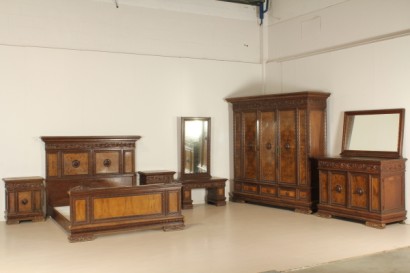Renaissance Room
Features
Style: Neo-Renaissance Revival
Origin: Italy
Main essence: Walnut
Material: Walnut Veneer , Solid Walnut , Walnut Burl
Description
Room features: closet: 220x22x67, Dresser: 104x141x64, Petenoise: 178x103x47, double bed: 145x187x217 and bedside tables: 73x64x40. Supported by carved feet, has three side doors that open with the riser and three drawers with turned knob. Fully veneered in Walnut Burl, presents three rosettes with knobs on the doors. Hat with carved belt ends with shaped frame. Chest of drawers with doors, supported by carved feet, has two doors with rosettes which open stations along the a-pillars. Under band-richly carved floor hides a drawer. Piano with carved border. Within three drawers. Mirror with hand carved wood. Petenoise governed by two elements that support the plan, band under richly carved floor, hides a drawer. Mirror with hand carved wood. Bed includes headboard and footboard, feather and paneled Walnut Burl and carved. Two carved roses are placed in the central panels of the headboard. Pair of bedside tables supported by carved feet, have a door that opens with an uppercut. The richly carved floor below hides the tray. Piano with carved border.
Product Condition:
Requires small restoration and resumption of polishing.
Additional Information
Style: Neo-Renaissance Revival
Stylistic revival, of the 20th century, of the forms typical of the Renaissance style.
This is a style that re-proposes, looking at the grandeur of the past, decorative motifs and ornaments typical of the 16th century.
Masks, frames, columns carved with herms that make up architectural structures typical of Renaissance palaces, are the elements that characterize the neo-Renaissance style.
These elements will remain in the production of furnishings until the early 1900s, contaminating themselves with floral elements.
Find out more about the Neo-Renaissance with our insights:
A Milanese library between Belle Epoque and Fascism
The Austrian taste of Baroque
Gothic sculpture
Art Déco
Neoclassical architecture




























































